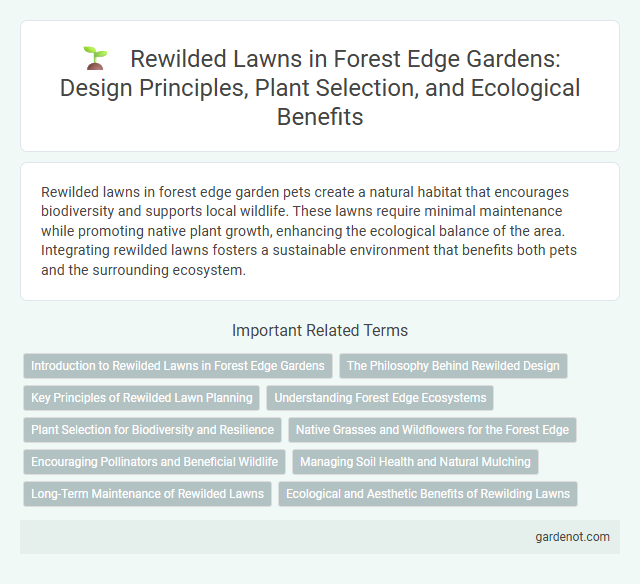Rewilded lawns in forest edge garden pets create a natural habitat that encourages biodiversity and supports local wildlife. These lawns require minimal maintenance while promoting native plant growth, enhancing the ecological balance of the area. Integrating rewilded lawns fosters a sustainable environment that benefits both pets and the surrounding ecosystem.
Introduction to Rewilded Lawns in Forest Edge Gardens
Rewilded lawns in forest edge gardens prioritize native plant species, promoting biodiversity and ecological balance. These lawns reduce the need for intensive maintenance by supporting natural habitats for pollinators and wildlife. Integrating wildflowers, grasses, and ground covers creates vibrant, resilient landscapes that enhance the forest edge ecosystem.
The Philosophy Behind Rewilded Design
Rewilded lawn design embraces natural processes by reducing intensive maintenance and promoting native biodiversity, allowing spontaneous growth of wildflowers and grasses that support pollinators and wildlife. This philosophy prioritizes ecological balance and resilience, creating a dynamic landscape that evolves with local ecosystems rather than conforming to traditional manicured aesthetics. Integrating rewilded lawns into forest edge gardens fosters a seamless transition between cultivated and wild spaces, enhancing habitat connectivity and sustaining ecosystem services.
Key Principles of Rewilded Lawn Planning
Rewilded lawn planning emphasizes native plant diversity, soil health, and minimal human intervention to create a resilient ecosystem that supports local wildlife. Prioritizing drought-tolerant grasses and wildflowers enhances biodiversity while reducing maintenance needs. Integrating habitat features such as logs, rocks, and water sources fosters ecological balance and promotes natural regeneration processes.
Understanding Forest Edge Ecosystems
Rewilded lawns at the forest edge promote biodiversity by mimicking natural ecosystems where grasslands meet woodlands, supporting diverse flora and fauna. These transitional zones enhance soil health, increase habitat complexity, and encourage native species proliferation. Understanding forest edge ecosystems reveals how edge effects influence microclimates and species interactions in rewilded garden designs.
Plant Selection for Biodiversity and Resilience
Choosing native grasses and wildflowers such as fescues, clovers, and oxeye daisies enhances biodiversity and supports local pollinators in a rewilded lawn. Incorporating deep-rooted perennials improves soil structure and drought resilience by promoting natural nutrient cycling and water retention. Selecting diverse plant species adapted to the local climate reduces maintenance needs and fosters a sustainable, resilient garden ecosystem at the forest edge.
Native Grasses and Wildflowers for the Forest Edge
A rewilded lawn at the forest edge thrives with native grasses like little bluestem and wild rye, complemented by wildflowers such as purple coneflower and black-eyed Susan. These species enhance biodiversity, support pollinators, and blend seamlessly with the surrounding woodland ecosystem. Establishing a native plant mix reduces maintenance and nurtures a resilient, sustainable garden habitat.
Encouraging Pollinators and Beneficial Wildlife
A rewilded lawn at the forest edge garden creates a natural habitat rich in native wildflowers and grasses that attract pollinators such as bees, butterflies, and hummingbirds. This diverse plant selection supports beneficial wildlife by providing essential nectar sources and shelter, enhancing local biodiversity. Managing the lawn with minimal mowing and avoiding pesticides encourages a thriving ecosystem that benefits the entire garden environment.
Managing Soil Health and Natural Mulching
A rewilded lawn at the forest edge garden thrives by prioritizing soil health management through organic matter enrichment and minimal disturbance practices. Natural mulching with fallen leaves and wood chips preserves moisture, suppresses weeds, and supports soil biodiversity essential for nutrient cycling. This approach fosters a resilient ecosystem, enhancing plant growth while reducing the need for synthetic fertilizers and pesticides.
Long-Term Maintenance of Rewilded Lawns
Long-term maintenance of rewilded lawns involves minimal mowing to promote biodiversity and soil health while preserving native plant species. Periodic selective cutting helps control invasive weeds without disrupting natural ecosystems, encouraging pollinators and wildlife habitats. Sustainable practices like seasonal raking and organic mulching support the lawn's resilience and ecological balance over time.
Ecological and Aesthetic Benefits of Rewilding Lawns
Rewilded lawns enhance biodiversity by providing native flora habitats that support pollinators, birds, and beneficial insects, fostering a balanced ecosystem at the forest edge garden. These lawns require less water and chemical inputs, promoting soil health and reducing environmental impact compared to traditional turfgrass. Visually, rewilded lawns create dynamic, textured landscapes with seasonal color and movement, enriching the garden's natural aesthetic appeal.
Rewilded lawn Infographic

 gardenot.com
gardenot.com